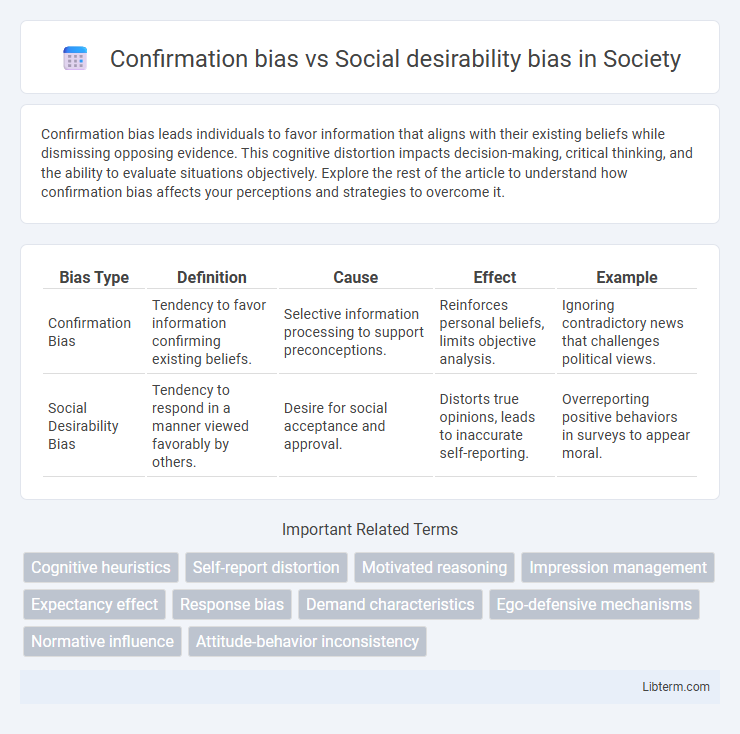Confirmation bias leads individuals to favor information that aligns with their existing beliefs while dismissing opposing evidence. This cognitive distortion impacts decision-making, critical thinking, and the ability to evaluate situations objectively. Explore the rest of the article to understand how confirmation bias affects your perceptions and strategies to overcome it.
Table of Comparison
| Bias Type | Definition | Cause | Effect | Example |
|---|---|---|---|---|
| Confirmation Bias | Tendency to favor information confirming existing beliefs. | Selective information processing to support preconceptions. | Reinforces personal beliefs, limits objective analysis. | Ignoring contradictory news that challenges political views. |
| Social Desirability Bias | Tendency to respond in a manner viewed favorably by others. | Desire for social acceptance and approval. | Distorts true opinions, leads to inaccurate self-reporting. | Overreporting positive behaviors in surveys to appear moral. |
Introduction to Cognitive Biases
Cognitive biases such as confirmation bias and social desirability bias significantly influence how individuals process information and make decisions. Confirmation bias leads people to favor information that confirms their preexisting beliefs, while social desirability bias drives individuals to respond in ways that are viewed favorably by others. Understanding these biases is crucial for improving critical thinking and reducing errors in judgment across various social and research contexts.
Defining Confirmation Bias
Confirmation bias is the cognitive tendency to search for, interpret, and remember information that confirms one's preexisting beliefs or hypotheses, often leading to skewed decision-making. It causes individuals to overlook or discount evidence that contradicts their views, reinforcing subjective judgments. This bias contrasts with social desirability bias, which involves altering responses to be viewed favorably by others rather than strengthening personal convictions.
Understanding Social Desirability Bias
Social desirability bias refers to the tendency of individuals to respond to questions or behave in ways that they believe will be viewed favorably by others, often leading to distorted or inaccurate data in surveys and research. This bias differs from confirmation bias, which involves favoring information that confirms one's preexisting beliefs. Understanding social desirability bias is crucial for designing effective survey methodologies, such as ensuring anonymity and using indirect questioning techniques to minimize its impact on data validity.
Key Differences Between Confirmation Bias and Social Desirability Bias
Confirmation bias involves favoring information that confirms preexisting beliefs, leading individuals to selectively gather or interpret evidence that supports their views. Social desirability bias causes respondents to answer questions in a manner they believe will be viewed favorably by others, often resulting in dishonest or skewed responses. The key difference lies in confirmation bias being internally driven by personal beliefs, while social desirability bias is externally motivated by the desire to conform to societal expectations.
Psychological Mechanisms Behind Each Bias
Confirmation bias occurs when individuals unconsciously seek, interpret, and remember information that supports their existing beliefs, driven by cognitive mechanisms like selective exposure and motivated reasoning. Social desirability bias stems from the psychological need for social approval, causing respondents to alter their answers to align with perceived social norms or expectations. Both biases involve cognitive and motivational processes but differ: confirmation bias is internally motivated by belief preservation, while social desirability bias is externally motivated by social influence and impression management.
Real-World Examples and Contexts
Confirmation bias commonly occurs in political decision-making, where individuals selectively seek information that supports their preexisting beliefs, reinforcing polarization. Social desirability bias frequently appears in survey responses about sensitive topics like drug use or voting behavior, causing participants to provide answers they believe are more socially acceptable rather than truthful. Both biases significantly impact data accuracy in fields such as psychology, marketing research, and public health studies.
Impacts on Decision-Making and Behavior
Confirmation bias leads individuals to favor information that supports their preexisting beliefs, resulting in skewed decision-making and resistance to contradictory evidence. Social desirability bias causes people to alter their behavior or responses to align with perceived social norms, often compromising authenticity and accuracy in social interactions and surveys. Both biases significantly distort judgment and behavior, impairing objective analysis and truthful communication in personal and professional contexts.
Implications in Research and Surveys
Confirmation bias skews research outcomes by prompting individuals to favor information that supports their preexisting beliefs, undermining objectivity and data validity. Social desirability bias affects survey responses as participants tailor answers to align with perceived societal norms, leading to distorted self-reports and inaccurate measurements. Both biases compromise data reliability, highlighting the need for carefully designed methodologies and unbiased question framing in empirical studies.
Strategies to Mitigate Both Biases
Strategies to mitigate confirmation bias include seeking out diverse perspectives, actively challenging one's own beliefs, and employing critical thinking techniques such as considering alternative hypotheses. To reduce social desirability bias, ensuring anonymity in responses, using indirect questioning methods, and creating a non-judgmental environment encourage honest reporting. Combining these approaches enhances the reliability and validity of data collection and decision-making processes in research and everyday interactions.
Conclusion: Navigating Bias in Everyday Life
Understanding the distinctions between confirmation bias and social desirability bias is crucial for making informed decisions and fostering authentic communication. Confirmation bias leads individuals to favor information that confirms their preexisting beliefs, while social desirability bias causes them to respond in ways that are perceived as socially acceptable rather than truthful. Navigating these biases requires cultivating critical thinking skills and creating environments that encourage honesty and diverse perspectives.
Confirmation bias Infographic

 libterm.com
libterm.com